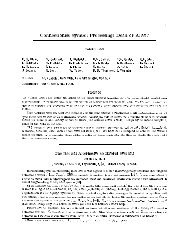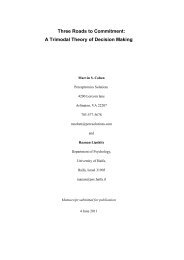Three Roads to Commitment: A Trimodal Theory of Decision Making
Three Roads to Commitment: A Trimodal Theory of Decision Making
Three Roads to Commitment: A Trimodal Theory of Decision Making
You also want an ePaper? Increase the reach of your titles
YUMPU automatically turns print PDFs into web optimized ePapers that Google loves.
<strong>Three</strong> <strong>Roads</strong> <strong>to</strong> <strong>Commitment</strong>: A <strong>Trimodal</strong> <strong>Theory</strong> <strong>of</strong> <strong>Decision</strong> <strong>Making</strong> 47<br />
One additional control tactic should be mentioned, which exploits the interaction between decision modes and<br />
uncertainty. As we have noted, different decision making modes pose questions about different issues; thus, the<br />
amount <strong>of</strong> uncertainty may be affected when the same decision maker views the same decision problem from the<br />
perspective <strong>of</strong> different modes. A situation that <strong>of</strong>fers high affordance for matching (e.g., by means <strong>of</strong> well-known<br />
rules for traditional role-based behavior) may be difficult <strong>to</strong> parse in terms <strong>of</strong> outcomes and their relative values (i.e.,<br />
choice). Conversely, in other situations it may be easy <strong>to</strong> identify the most advantageous option (choice) but difficult<br />
<strong>to</strong> decide if it is ethical (matching). Finding a successful action by experimentation (i.e., reassessment) may be easier<br />
than choice or matching if the situation is novel and actions are reversible; but choice or matching will be easier<br />
when actions are costly and the domain is well unders<strong>to</strong>od. These affordances may well influence which mode is<br />
used. For the same reasons, decision makers may find themselves changing modes if uncertainty becomes excessive;<br />
for example, a decision maker may decide <strong>to</strong> follow the usual practice rather than trust an assumption-laden analysis<br />
<strong>of</strong> outcomes. Whether this happens depends not only on uncertainty but on dispositions <strong>to</strong> favor different modes,<br />
which may vary in strength with individual experience, personality, social context, task, domain, and cultural<br />
background. 21<br />
All three modes play a role in determination <strong>of</strong> the decision making process: Matching primes secondary<br />
questions and a path <strong>to</strong> commitment, and reassessment fills in when the process includes random search rather than<br />
guidance by questions; the balance <strong>of</strong> the two determines action uncertainty. Choice helps manage time, the<br />
selection <strong>of</strong> methods, and <strong>to</strong> some degree the selection <strong>of</strong> modes – i.e., the amount <strong>of</strong> effort that is actually expended<br />
<strong>to</strong> overcome action uncertainty. Simultaneously, the first-order decision making mode that is supported by these<br />
commitment, simulation with cost <strong>of</strong> delay curves taken from Figure 6A and uncertainty handling efficiency curves<br />
from Figure 6B, predicts the following: When delay costs and uncertainty handling efficiency are both negatively<br />
accelerated, the prediction is straightforward: uncertainty handling will occur before commitment if and only if its<br />
benefits rise faster than its costs. However, if either delay cost or method efficiency has an S-shaped curve, results<br />
can be problematic. For example, if shorter periods <strong>of</strong> deliberation are tried first, they may be decremented until they<br />
eventually disappear in favor <strong>of</strong> immediate commitment, despite potential benefits from longer deliberation; if long<br />
periods <strong>of</strong> deliberation are tried first, they may be incremented while action is indefinitely delayed, despite benefits<br />
from earlier action. These findings underscore the importance <strong>of</strong> deliberate exposure <strong>to</strong> different durations under<br />
these conditions (note 19).<br />
21 The hypothesis that decision makers will tend <strong>to</strong> avoid the use <strong>of</strong> modes where uncertainty is high relative <strong>to</strong> other<br />
modes can be experimentally tested, by presenting scenarios with characteristics like those described in the text, and<br />
assessing the impact on decision mode by criteria described in note 9. Mode-specific uncertainty may interact with<br />
cultural and personal values in their effects on decision mode, as described in note Error! Bookmark not defined..




